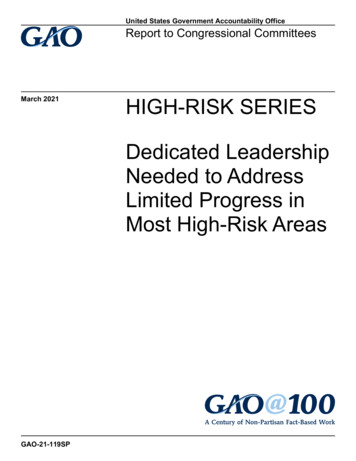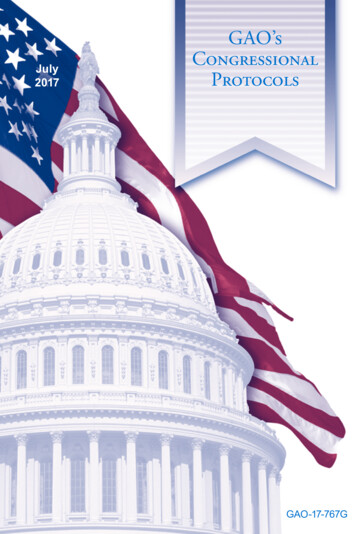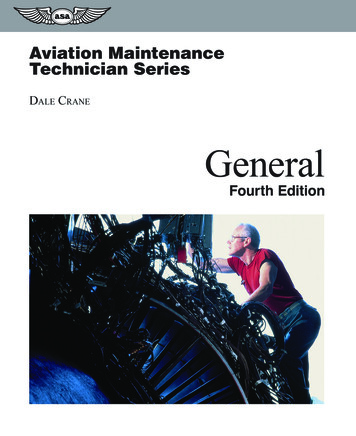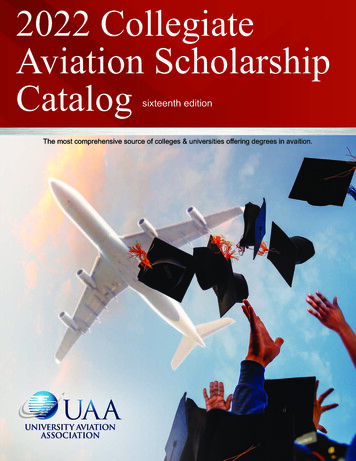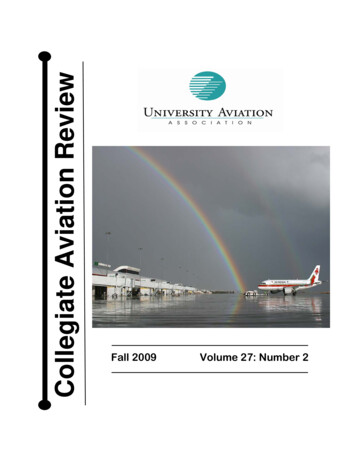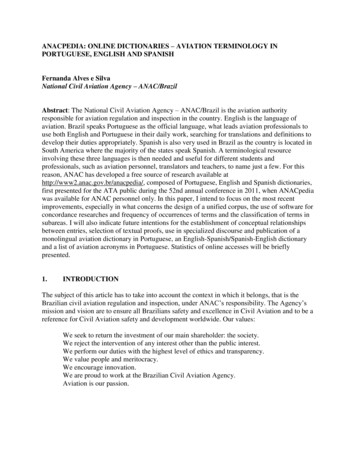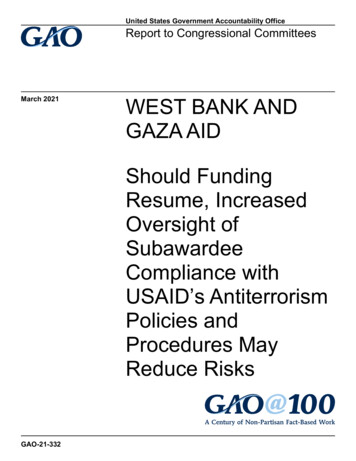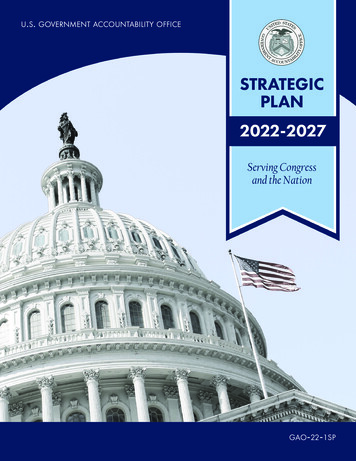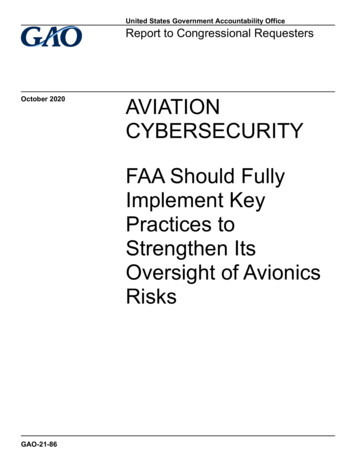
Transcription
United States Government Accountability OfficeReport to Congressional RequestersOctober 2020AVIATIONCYBERSECURITYFAA Should FullyImplement KeyPractices toStrengthen ItsOversight of AvionicsRisksGAO-21-86
October 2020AVIATION CYBERSECURITYFAA Should Fully Implement Key Practices toStrengthen Its Oversight of Avionics RisksHighlights of GAO-21-86, a report tocongressional requestersWhy GAO Did This StudyWhat GAO FoundAvionics systems, which provideweather information, positioning data,and communications, are critical tothe safe operation of an airplane.FAA is responsible for overseeing thesafety of commercial aviation,including avionics systems. Thegrowing connectivity betweenairplanes and these systems maypresent increasing opportunities forcyberattacks on commercialairplanes.Modern airplanes are equipped with networks and systems that share data withthe pilots, passengers, maintenance crews, other aircraft, and air-trafficcontrollers in ways that were not previously feasible (see fig. 1). As a result, ifavionics systems are not properly protected, they could be at risk of a variety ofpotential cyberattacks. Vulnerabilities could occur due to (1) not applyingmodifications (patches) to commercial software, (2) insecure supply chains, (3)malicious software uploads, (4) outdated systems on legacy airplanes, and (5)flight data spoofing. To date, extensive cybersecurity controls have beenimplemented and there have not been any reports of successful cyberattacks onan airplane’s avionics systems. However, the increasing connections betweenairplanes and other systems, combined with the evolving cyber threat landscape,could lead to increasing risks for future flight safety.GAO was asked to review the FAA’soversight of avionics cybersecurityissues. The objectives of this reviewwere to (1) describe keycybersecurity risks to avionicssystems and their potential effects,(2) determine the extent to which FAAoversees the implementation ofcybersecurity controls that addressidentified risks in avionics systems,and (3) assess the extent to whichFAA coordinates internally and withother government and industryentities to identify and addresscybersecurity risks to avionicssystems.To do so, GAO reviewed informationon key cybersecurity risks to avionicssystems, as reported by majorindustry representatives as well askey elements of an effective oversightprogram, and compared FAA’sprocess for overseeing theimplementation of cybersecuritycontrols in avionics systems withthese program elements. GAO alsoreviewed agency documentation andinterviewed agency and industryrepresentatives to assess FAA’scoordination efforts to address theidentified risks.View GAO-21-86. For more information,contact Nick Marinos at (202) 512-9342 orMarinosN@gao.gov, or Heather Krause at(202) 512-2834 or KrauseH@gao.gov.Figure 1: Key Systems Connections to Commercial AirplanesThe Federal Aviation Administration (FAA) has established a process for thecertification and oversight of all US commercial airplanes, including the operationof commercial air carriers (see fig. 2). While FAA recognizes avionicscybersecurity as a potential safety issue for modern commercial airplanes, it hasnot fully implemented key practices that are necessary to carry out a risk-basedcybersecurity oversight program.United States Government Accountability Office
What GAO RecommendsGAO is making six recommendationsto FAA to strengthen its avionicscybersecurity oversight program: GAO recommends that FAAconduct a cybersecurity riskassessment of avionics systemscybersecurity within its oversightprogram to identify the relativepriority of avionics cybersecurityrisks compared to other safetyconcerns and develop a plan toaddress those risks.Specifically, FAA has not (1) assessed its oversight program to determine thepriority of avionics cybersecurity risks, (2) developed an avionics cybersecuritytraining program, (3) issued guidance for independent cybersecurity testing, or(4) included periodic testing as part of its monitoring process. Until FAAstrengthens its oversight program, based on assessed risks, it may not be able toensure it is providing sufficient oversight to guard against evolving cybersecurityrisks facing avionics systems in commercial airplanes.Figure 2: Federal Aviation Administration’s Certification Process for Commercial TransportAirplanesBased on the assessment of avionicscybersecurity risks, GAO recommendsthat FAA identify staffing and training needsfor agency inspectors specific toavionics cybersecurity, anddevelop and implementappropriate training to addressidentified needs.develop and implement guidancefor avionics cybersecurity testingof new airplane designs thatincludes independent testing.review and consider revising itspolicies and procedures formonitoring the effectiveness ofavionics cybersecurity controls inthe deployed fleet to includedeveloping procedures for safelyconducting independent testing.ensure that avionics cybersecurityissues are appropriately trackedand resolved when coordinatingamong internal stakeholders.review and consider the extent towhich oversight resources shouldbe committed to avionicscybersecurity.FAA concurred with five out of sixGAO recommendations. FAA didnot concur with therecommendation to considerrevising its policies andprocedures for periodicindependent testing. GAO clarifiedthis recommendation toemphasize that FAA safelyconduct such testing as part of itsongoing monitoring of airplanesafety.GAO has previously identified key practices for interagency collaboration that canbe used to assess interagency coordination. FAA coordinates with other federalagencies, such as the Departments of Defense (DOD) and Homeland Security(DHS), and with industry to address aviation cybersecurity issues. For example,FAA co-chairs the Aviation Cyber Initiative, a tri-agency forum with DOD andDHS to address cyber risks across the aviation ecosystem. However, FAA’sinternal coordination activities do not fully reflect GAO’s key collaborationpractices. FAA has not established a tracking mechanism for monitoring progresson cybersecurity issues that are raised in coordination meetings, and itsoversight coordination activities are not supported by dedicated resources withinthe agency’s budget. Until FAA establishes a tracking mechanism forcybersecurity issues, it may be unable to ensure that all issues are appropriatelyaddressed and resolved. Further, until it conducts an avionics cybersecurity riskassessment, it will not be able to effectively prioritize and dedicate resources toensure that avionics cybersecurity risks are addressed in its oversight program.
ContentsLetter1BackgroundIncreasing Cybersecurity Risks to Avionics Systems, IfUnaddressed, Could Impact Flight Safety as Airplanes BecomeMore ConnectedFAA Has Not Fully Implemented Key Practices to OverseeIndustry Mitigation of Avionics Cybersecurity RisksFAA Has Taken Steps to Coordinate Cybersecurity Issues, butHas Not Focused on Avionics Cybersecurity RisksConclusionsRecommendations for Executive ActionAgency Comments and Our Evaluation535424344Appendix IComments from the Department of Defense46Appendix IIComments from the Department of Transportation47Appendix IIIGAO Contacts and Staff Acknowledgments491926FiguresFigure 1: Key Systems Connections to Commercial AirplanesFigure 2: FAA’s Certification Process for Commercial TransportAirplanesFigure 3: Examples of FAA’s External Coordinating Mechanismsfor Aviation Cybersecurity Activities, Issues, Rulemaking,or Technical AdvicePage i61137GAO-21-86 Aviation Cybersecurity
tGenNISTNSASRTCATSAAircraft Communications Addressing and ReportingSystemAviation Cyber InitiativeAutomatic Dependent Surveillance-BroadcastAvionics Full-Duplex Switched EthernetFlight Standards ServiceAircraft Certification ServiceAviation Information Sharing and Analysis CenterAeronautical Radio, Inc.Security and Hazardous Material SafetyAir Traffic ControlAviation SafetyCode of Federal RegulationsCyber Safety Commercial Aviation TeamDepartment of Homeland SecurityDepartment of DefenseEuropean Organisation for Civil Aviation EquipmentEuropean Aviation Safety AgencyFederal Aviation AdministrationInternational Civil Aviation Organizationin-flight entertainmentinstrument landing systemNext Generation Air Transportation SystemNational Institute of Standards and TechnologyNational Strategy for Aviation SecurityRadio Technical Commission for AeronauticsTransportation Security AdministrationThis is a work of the U.S. government and is not subject to copyright protection in theUnited States. The published product may be reproduced and distributed in its entiretywithout further permission from GAO. However, because this work may containcopyrighted images or other material, permission from the copyright holder may benecessary if you wish to reproduce this material separately.Page iiGAO-21-86 Aviation Cybersecurity
Letter441 G St. N.W.Washington, DC 20548October 9, 2020The Honorable Susan M. CollinsChairmanThe Honorable Jack ReedRanking MemberSubcommittee on Transportation,Housing and Urban Development,and Related AgenciesCommittee on AppropriationsUnited States SenateThe U.S. aviation industry—including passenger air carriers, cargo aircarriers, and aviation manufacturers and contractors—is vital to the U.S.economy. Generating billions of dollars in revenue each year, the aviationindustry plays a substantial role in catalyzing economic growth andinfluencing the quality of peoples’ lives around the globe. Although theCOVID-19 pandemic has impacted the industry by diminishing passengerdemand for air travel, Congress and the administration have taken aseries of actions to assist the industry and ensure continued flightoperations. 1These flight operations are enabled by the global network of airframemanufacturers, suppliers, carriers, airports, and other entities—generallyreferred to as the aviation ecosystem. The interdependencies across theaviation ecosystem underscore the importance of identifying, mitigating,and coordinating cybersecurity risks to ensure the safe operation ofcommercial airplanes in the National Airspace System. 2 Flight-criticalairplane systems, known as avionics systems, are a key aspect of theNational Airspace System. These include systems that provide weatherinformation, positioning data, and communications to the airplane.1COVID-19relief laws enacted as of May 31, 2020, include the Coronavirus Preparednessand Response Supplemental Appropriations Act, 2020, Pub. L. No. 116-123, 134 Stat.146; Families First Coronavirus Response Act, Pub. L. No. 116-127, 134 Stat. 178 (2020);CARES Act, Pub. L. No. 116-136, 134 Stat. 281 (2020); and Paycheck ProtectionProgram and Health Care Enhancement Act, Pub. L. No. 116-139, 134 Stat. 620 (2020).2TheNational Airspace System was created by the FAA to protect persons and propertyon the ground, and to establish a safe and efficient airspace environment for civil,commercial, and military aviation. The National Airspace System is made up of a networkof air navigation facilities, air traffic control facilities, airports, technology, and appropriaterules and regulations that are needed to operate the system.Page 1GAO-21-86 Aviation Cybersecurity
The Federal Aviation Administration (FAA) is responsible for the safetyand oversight of commercial aviation, which includes the certification andoversight of all US commercial airplanes and the operation of commercialair carriers, among other things. Other federal agencies, such as theDepartment of Defense (DOD) and the Department of Homeland Security(DHS), have responsibilities related to airplane cybersecurity research incoordination with FAA and other stakeholders across the aviationecosystem.You asked us to review cybersecurity risks to avionics systems and thesufficiency of FAA’s oversight of efforts to address these risks.Specifically, our objectives were to (1) describe key cybersecurity risks toavionics systems and their potential effects, (2) determine the extent towhich FAA oversees the implementation of cybersecurity controls thataddress identified risks in avionics systems, and (3) assess the extent towhich FAA coordinates internally and with other government and industryentities to identify and address cybersecurity risks to avionics systems.To address the first objective, we developed a list of cyber threat actorsthat could pose a threat to commercial airplanes, identified internal andexternal electronic connections to airplane avionics systems that could beexploited, and identified the potential risks of cyberattacks if thosevulnerabilities were exploited. To develop the list of cyber threat actors,we reviewed our previously issued report on cyber-based threats facingcritical infrastructure, 3 as well as the threats identified by the 2019Worldwide Threat Assessment of the U.S. Intelligence Community. 4 Wealso analyzed FAA documentation and public information, such assecurity consultant reports, to identify and describe major potentialvulnerabilities on commercial transport airplanes.In addition, we interviewed officials and representatives from the followingentities to identify and discuss their perspectives regarding the significantcyber threats to avionics systems:3GAO,Critical Infrastructure Protection: Actions Needed to Address SignificantCybersecurity Risks Facing the Electric Grid, GAO-19-332 (Washington, D.C.: Aug. 26,2019).4DanielR. Coats, Director of National Intelligence, Worldwide Threat Assessment of theU.S. Intelligence Community, testimony before the Senate Select Committee onIntelligence, 116th Cong. 1st sess., January 29, 2019.Page 2GAO-21-86 Aviation Cybersecurity
Federal agencies. Officials from DOD, DHS, and FAA that carry outaviation cybersecurity responsibilities for their agency. Airlines. Representatives of American Airlines, Alaska Airlines, DeltaAirlines, JetBlue Airlines, Southwest Airlines, and United Airlines. Weselected these airlines because they had the greatest number ofdomestic departures in 2018. Manufacturers. Knowledgeable representatives from airframe,avionics, and engine manufacturers that were selected based on theirroles as major US-based aviation industry manufacturers. Specifically,we interviewed representatives from Boeing, Airbus, Rolls Royce, GEAviation, and Rockwell Collins. Industry associations. Representatives from the AviationInformation Sharing & Analysis Center (A-ISAC) and the AerospaceIndustries Association. International organizations. Representatives from the EuropeanUnion Aviation Safety Agency (EASA) and the International CivilAviation Organization (ICAO). Subject matter experts. Representatives from Pen Test Partners, asecurity consultancy firm, and Dr. Karl Koscher from the University ofWashington and Dr. Stefan Savage from the University of CaliforniaSan Diego. These individuals are involved in security research andairplane avionics systems testing research. They were selectedbecause of their research experience with testing cybersecuritycontrols for avionics systems.To address the second objective, we identified four key elements of aneffective oversight program by reviewing National Institute of Standardsand Technology (NIST) guidance 5 and previous GAO reports on effectiveoversight programs. 6 These elements include (1) an assessment of risks,(2) training, (3) independent testing, and (4) ongoing monitoring.We then obtained and analyzed information on the policies, procedures,and processes that FAA has in place for overseeing the implementationof cybersecurity controls in avionics systems. We assessed the5NISTSpecial Publication 800-39, Managing Information Security Risk (Gaithersburg, MD:2011). NIST Special Publication 800-53, Security and Privacy Controls for FederalInformation Systems and Organizations, Rev. 4 (Gaithersburg, MD: April 2013).6GAO,Cybersecurity: Office of Federal Student Aid Should Take Additional Steps toOversee Non-School Partners’ Protection of Borrower Information, GAO-18-518(Washington, D.C.: Sept. 17, 2018).Page 3GAO-21-86 Aviation Cybersecurity
consistency of these policies, procedures, and processes with the keyelements of an effective oversight program.Further, we conducted a site visit to FAA and Boeing facilities in Seattle,Washington. We interviewed Boeing officials regarding themanufacturer’s processes for securing avionics systems from cyberattackduring the manufacturing and certification processes. We also interviewedFAA officials in Seattle regarding their oversight practices as they reviewcybersecurity during certification. In addition to Boeing, we alsointerviewed Airbus, suppliers, airline officials, and other industryrepresentatives to understand their respective roles in ensuringcybersecurity for airplane flight systems and to obtain their views on thesufficiency of FAA’s efforts in overseeing avionics cybersecurity.To address the third objective, we assessed the National Strategy forAviation Security 7 and NIST’s cybersecurity risk management guidance toidentify the key requirements for managing and responding to risk at theorganizational level: (1) determining cybersecurity risks, (2) developingactions to respond to them, and (3) monitoring the results. 8Further, for the agency’s internal coordination efforts, we reviewed theextent to which FAA has adopted key practices, as identified in GAO’sguide for implementing interagency collaborative mechanisms. 9 Weassessed FAA documentation, such as strategies, plans, and directivesdescribing cybersecurity coordination efforts across its internalcomponents, against these collaborative practices to determine whetherthey had been fully implemented.We then interviewed officials from FAA, DOD, and DHS, in addition toaviation industry stakeholders, regarding the extent to which coordinationamong government agencies, including internal FAA components, andindustry stakeholders, addressed the identified avionics cybersecuritythreats. We also obtained the views of industry officials and subject7WhiteHouse, National Strategy for Aviation Security of the United States of America,(Washington, D.C.: December 2018).8NIST2011).Special Publication 800-39, Managing Information Security Risk (Gaithersburg, MD:9GAO,Managing for Results: Key Considerations for Implementing InteragencyCollaborative Mechanisms, GAO-12-1022 (Washington, D.C.: Sept. 27, 2012).Page 4GAO-21-86 Aviation Cybersecurity
matter experts on FAA’s efforts to coordinate specifically on avionicscybersecurity risks.We conducted this performance audit from April 2019 to October 2020 inaccordance with generally accepted government auditing standards.Those standards require that we plan and perform the audit to obtainsufficient, appropriate evidence to provide a reasonable basis for ourfindings and conclusions based on our audit objectives. We believe thatthe evidence obtained provides a reasonable basis for our findings andconclusions based on our audit objectives.BackgroundAviation Ecosystem andAvionics SystemsThe aviation ecosystem is a large and complex international entity withmany stakeholders. It consists of airplane manufacturers and air carriers,their employees, customers, suppliers, and vendors; other aviationrelated companies; standards-making bodies, regulators, domestic andinternational research and policy-making bodies, and other aviationrelated organizations; aviation-related products and equipment, such asairplanes and airplane components and systems; air traffic controlpersonnel, equipment, and systems; communication systems among thevarious parties; and other aviation-related items.Airplanes are the centerpiece of the aviation ecosystem. Further, avionicssystems are generally considered one of the most critical components ofan airplane due to their criticality for safe flight operations. They includeengine controls, flight control systems, navigation, communications, flightrecorders, lighting systems that provide interior and exterior illumination,fuel systems, weather radar, performance monitors, and systems thatcarry out hundreds of other mission and flight management tasks. In thisreport, we refer to avionics systems as any systems available to the flightcrew or maintenance crew that are critical for the safe operation andmaintenance of an airplane. Systems that exclusively provide customerservices, such as in-flight entertainment, are not considered part ofavionics systems.Commercial AirplaneSystems Are BecomingMore ConnectedHistorically, the networks on an airplane were used primarily to exchangedata among onboard systems. Now, modern commercial airplanes areequipped with networks and systems that share data with the flight crews,passengers, other airplanes, maintenance crews, and air trafficcontrollers in ways that were not previously feasible. Such network andsystem connections are depicted in figure 1.Page 5GAO-21-86 Aviation Cybersecurity
Figure 1: Key Systems Connections to Commercial AirplanesMultiple networks for transmitting data internally and externally may be inplace on any given airplane, and these networks provide many differenttypes of connections between avionics and other systems. Theconnectivity of these networks varies, depending on the technicalstandards used to implement them. For example, commercial airplaneshave traditionally used networks that relied on the Aeronautical Radio,Inc. (ARINC) 429 standard. Devised in 1977, this standard originallydefined a one-way data bus that enhanced security by severely limitinghow data and electronic commands could be exchanged. 10More advanced networks provide more efficient, two-waycommunications by using a new data bus standard developed byRockwell Collins in 2005, called Avionics Full Duplex Switched Ethernet10A data bus is a system within a computer or device that consists of a connector or set ofwires that provide transportation for data.Page 6GAO-21-86 Aviation Cybersecurity
(AFDX). Airlines and manufacturers use the enhanced capabilities of theAFDX standard on newer airplanes to capture and provide data about thecondition of various airplane components and systems—includingavionics systems—to maintenance crews so that issues can be resolvedquickly.Avionics systems use these advanced networks to exchange operationaldata with multiple systems located outside of the airplane. For example,certain airplanes are equipped with a system known as the AutomaticDependent Surveillance-Broadcast (ADS-B) that periodically broadcastsdata such as flight identification number, current position, altitude, andvelocity, which can be received by FAA air traffic control (ATC) systemsfor tracking purposes. Likewise, the Aircraft Communications Addressingand Reporting System (ACARS) communicates data, such as flight plansand weather information from ATC, between the airplane and groundsystems and sends that data directly to flight management systems.In addition, we have previously reported on FAA’s efforts to implementthe Next Generation Air Transportation System (NextGen), whichincludes ADS-B and is designed to transition the nation’s ground-basedair traffic control system to one that uses satellite navigation, automatedposition reporting, and digital communications. 11 NextGen is alsodesigned to include enhanced interactions with airplane avionics systems.Airplane DomainsThe aviation industry has defined conceptual airplane domains forcommercial transport airplanes that are used as an aid to discusscybersecurity protections with the understanding that airplanearchitectures can vary widely. As shown in figure 1, an airplane typicallyhas three domains: (1) aircraft control, (2) airline information services,and (3) passenger information and entertainment services. The airlineinformation services and passenger information and entertainmentservices domains may require connectivity with ground-based computingnetworks, such as those for maintenance and operations. The functionsof each domain are as follows: Aircraft control domain. The most critical of the three domains, thisdomain consists of systems and networks whose primary function isto support the safe operation of the airplane. The domain includes theairplane’s avionics and the flight controls, all air traffic controlfunctions, flight management and navigation systems, and passenger11GAO,Air Traffic Control Modernization: Progress and Challenges in ImplementingNextGen, GAO-17-450 (Washington, D.C.: Aug. 31, 2017).Page 7GAO-21-86 Aviation Cybersecurity
safety systems, such as environmental control and smoke detectionsystems, among many others. The systems in the aircraft controldomain are separated from other airplane systems.Federal Agencies HaveSpecific Roles inSupporting AviationCybersecurity Airline information services domain. This domain provides servicesand connectivity between other airplane domains, such as aircraftcontrol, passenger information and entertainment services, and anyconnected off-board networks. For example, this domainencompasses crew systems, including flight management devicesknown as electronic flight bags, 12 fault monitoring systems,maintenance systems, and airport ground-based communications,which must remain isolated from the passenger domain. In addition,this domain provides a limited amount of data through a one-way (or“read-only”) channel to the passenger domain from the aircraft controldomain so passengers can receive flight status updates. While thisdomain includes data that support the safe operation of the airplane,systems within this domain do not have the ability to issue commandsthat directly control the airplane. Passenger information and entertainment services domain. Thisdomain includes any device or function that provides services topassengers, including in-flight entertainment (IFE) systems, cabinmanagement systems (such as cabin lighting and galley operations),and other passenger-facing systems. For example, this domain allowspassengers to access the Internet with their personal devices, such aslaptops and tablets. It may encompass multiple systems from differentvendors that may or may not be interconnected with one another.Three agencies have distinct roles and responsibilities with regard toaviation cybersecurity. Federal Aviation Administration. FAA has regulatory authority overthe safety of civil aviation, which includes air traffic control and otherground operations as well as aircraft. The agency serves as co-leadwith DHS on infrastructure protection activities for the aviationsubsector of the transportation system critical infrastructure sector.12An electronic flight bag (EFB) is an electronic device used by the flight crew that displaysdigital documentation, including navigational charts, operations manuals, and airplanechecklists, replacing the physical flight bags that contained paper versions of thesedocuments and other tools in the past. EFBs can also perform basic flight planningcalculations. The most advanced electronic flight bags are included in the airplane’scertified avionics systems and are fully integrated with the flight management system andother avionics systems. These advanced EFBs can display an airplane’s position onnavigational charts, depict real-time weather, and perform many complex flight-planningtasks.Page 8GAO-21-86 Aviation Cybersecurity
Specifically, FAA is responsible for the safety and oversight ofcommercial aviation, which includes the certification and oversight ofall US commercial aviation products and commercial entities. Theseinclude commercial airplanes and their avionics systems, airframe andcomponent manufacturers, and air carriers. To the extent thatcybersecurity risks could threaten the safety of civil aviation, FAA isresponsible for overseeing efforts to mitigate those risks. Department of Homeland Security. DHS is the lead federal agencyfor cybersecurity protection. With regard to aviation, DHS isresponsible for coordinating federal government activities addressingaviation security. DHS is to conduct these activities by identifyingconflicting procedures, identifying vulnerabilities and consequences,and coordinating corresponding interagency mitigation actions.Further, DHS is responsible for overseeing critical aviation andtransportation security activities, such as airport security, through theTransportation Security Administration (TSA). The Cybersecurity andInfrastructure Security Agency, a component within DHS, isresponsible for identifying cybersecurity vulnerabilities andcoordinating mitigation actions across the federal government,including aviation cybersecurity research efforts. Department of Defense. DOD conducts its missions within theNational Airspace System as both an airplane operator and, asdelegated by the FAA, a provider of air traffic control and other airnavigation services. DOD has the authority to certify its own airplanes,manage airspace, and provide air traffic control-related services inaccordance with FAA requirements. DOD is also responsible foraviation security programs and initiatives that support nationalsecurity. The Air Force has several on-going efforts to addresscybersecurity risks, including the Air Force Aircraft Cyber ThreatWorking Group to facilitate a threat-informed and risk-based approachto aviation cybersecurity and multiple programs to identify andmitigate cybersecurity vulnerabilities in airplanes. In 2016, the AirForce stood up the Cyber Resiliency Office for Weapons Systems tointegrate cyber resiliency into new airplanes and avionics programs,which includes cyber resiliency on fielded airplanes and associatedavionics systems.The National Strategy for Aviation Security, which the White Houseissued in December 2018, describes the federal government’s approachto securing the aviation ecosystem, prioritizing protective activities, andPage 9GAO-21-86 Aviation Cybersecurity
interagency collaboration.
Page 2 GAO-21-86 Aviation Cybersecurity . The Federal Aviation Administration (FAA) is responsible for the safety and oversight of commercial aviation, which includes the certification and oversight of all US commercial airplanes and the operation of commercial air carriers, among other things. Other federal agencies, such as the
